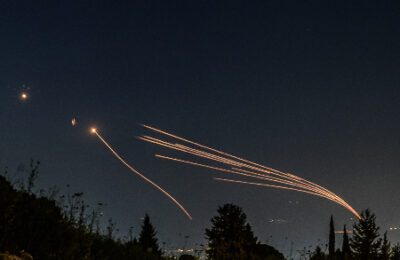“Spot” is a striking, 30-foot-high sculpture of a dalmatian balancing a real yellow New York City taxi cab on its nose. It is a striking public art installation that stands in front of NYU hospital. The purpose in creating this playful sculpture was to make kids coping with illness pause and smile before passing through the hospital corridors to receive their treatments.

Spoonbridge and Cherry, Walker Art Museum, Minneapolis (IJN file photo)
Of course, in Denver, who could miss our giant 40-foot blue bear peering into the Colorado Convention Center? It embodies that curiosity we all sometimes have about what is happening behind closed doors. Officially, the blue bear sculpture is named “I See What You Mean.”
“Troubles In The Square,” in Israel, is a scene of metal cut-outs of people and birds, sprawled on a piazza-like square. The placement of the birds and the shadows cast on the two dimensional metal somehow does bring to life a sense of birds-in-flight. While some of the figures are bent over, which can be interpreted as embodying burden, the birds curve toward, almost as if whispering, thus balancing out the scene with the possibility of playfulness.
There are so many truly amazing public works of art around the world. Of course in a country like Italy, in some cities it seems like there is a sculptural masterpiece from antiquity, around practically every other corner.
Often these works of art add another layer and vibe to a street or a town. Sometimes, they define the space entirely.
Here are a few sculptures I hope to one day see. “Spoonbridge and Cherry” in Minneapolis. It’s a spoon that arcs over a pond in a park, studded with a cherry at its summit. It looks so pretty and so very whimsical. It practically calls out to pose standing on the Spoonbridge with double scoop ice cream cones in hand.
“Clothespin” in Philadelphia. It’s just one huge clothespin, that’s all. But how interesting to take such a banal object used in daily life or, rather, one that has become virtually obsolete, and elevate it to art.
Although there is no laundry to be seen, it evokes the image of a clothesline with drying clothes or sheets flapping in the wind.
“Mustangs” in Las Colinas, Texas. It’s a cluster of horses galloping in a fountain. The sculpture is sculpted so fluidly, it almost feels like the horses are right there, truly galloping.
England has two that are intriguing. There is “The Singing Tree.” It is constructed with materials and shapes, as well as at an angle, so that when the wind blows it blows music through this sculpted tree. Each time, nature produces a different melody in that very moment, never to be heard again.
The next one is a homage to hurricanes. How can something non-tangible like the force of a wind be shaped and molded into metal material? Yet, the sculpture “Force of Nature” manages to embody the kinetic power of a hurricane’s wind as it hurls toward the earth.
Lake Geneva, Switzerland’s “Melancholy” is profound. A stooped over person sits on a bench. The only thing is, the center of the body is a huge empty hole. The sculpture is meant to illustrate the emptiness, the void, that a bereaved person lives with.
In a similar vein. There is “Le Voyageurs” in Marseille, France. You see a few men on a beach, carrying suitcases, only parts of their bodies are spookily missing.
On the Danube in Budapest is the haunting “Shoes On The Danube.” Endless bronzed shoes, different shapes and sizes, for big feet and small ones, commemorate the Hungarian Jews who were ordered to leave their shoes on the banks of the river before they were shot. It’s such a little detail of life, a shoe. Yet, it aids the ability to walk through life. To see those bronzed empty shoes and imagine a pair of live feet walking in them, and the reason why they are now empty, speaks volumes.
A group of boys jump into the Singapore River. Again the quality of fluidity is so remarkable. The sculpture of the boys — some even in mid-air — almost feels kinetic. Somehow the buoyancy of the boys can be felt. It’s “First Generation” in Singapore.
Almost like “Jacob’s ladder,” in the Botanic Gardens in New Zealand is an aluminum welded staircase called “Diminish and Ascend.” You can practically see the angels from Jacob’s dream ascending and descending on the steps that lead to the heavens.
Turning a manhole on the sidewalk into art takes some real creativity. “Cumil” in Slovak, meaning “The Watcher,” is a sculpture in Bratislava, Slovakia that succeeds in doing just that. It’s a vision of a man peeking from the sidewalk. Maybe it’s just meant to be the visage of a man taking a look at what is happening on the street after a long day’s work. To me, though, I think of a sewer worker who risked his life and saved Jews by hiding them underground in a sewer in Poland during the Holocaust, peeking out stealthily, cautiously, prior to emerging from below.
Like all art, different sculptures evoke and impact different reactions in each person.
There must be thousands of striking sculptures around the world. I’m sure you can add many more of your own to this list.
I just find myself thinking of Israel’s “Trouble In The Square” right now, and hope this tense time passes safely.
Copyright © 2023 by the Intermountain Jewish News












